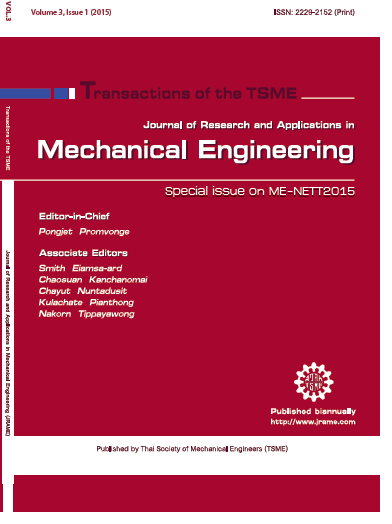Diversity factor analysis of energy consumption for school building
Main Article Content
Abstract
The energy conservation in Thailand is concerned and supported by Ministry of Energy and government policy. In the past, the energy consumption was obtained by energy audit or energy measurement from actual power of main systems. The ratio between the actual power (Pact) and the rated power (Pmax) of systems defined as the diversity factor that was also used to analyze the energy consumption. In this study, the diversity factor was obtained by the actual power measured from the energy consumption behavior in the school building and maximum power. The energy consumption was simply evaluated by using 3 methods of diversity evaluation as the approximated diversity factor (Da) with and without measurement and the measured diversity factor (Dm). In this study, the approximated diversity factor, Da =0.80 was used and the average measured diversity factor, Dm =0.70 was obtained. As the results, 46.28%, 18.08% and 2.18% of energy consumption deviation were found from using the approximated diversity factor without measurement, the approximated diversity factor with measurement and the measured diversity factor, respectively. However the energy consumption analyzed by the approximated diversity factor did not measure from the actual power and the energy consumption behavior which showed the highest deviation from the actual value. The results showed that the energy consumption analyzed from the measured diversity factor with measurement could reflect the consumption behavior of the school building.
Article Details
This work is licensed under a Creative Commons Attribution-NonCommercial-ShareAlike 4.0 International License.
References
[2] Kunchornrat, J. Study of energy consumption in dormitory of King Mongkut’s University of Technology Thonburi, Mechanical Engineering of Network of Thailand, 2005.
[3] Chirarattananont, S. Study of lighting duct used in building, Asian Institute of Technology, Thailand, 2005.
[4] Kaewpradap A. and Namprakai P., Study specific energy consumption (SEC) in metal industry, E-NETT, Thailand, 2005.
[5] Pulsin, U. Energy saving for non-designated building, Master thesis of King Mongkut’s University of Technology Thonburi, 2003.
[6] Katejanekarn, T. Simulation of energy saving in school building, Mechanical Engineering of Network of Thailand, 2007.
[7] IEEE Standard 141(TM), IEEE Recommended Practice for Electric Power Distribution for Industrial Plants, Red Book, 1993.
[8] Handbook for Electricity Metering, Edison Electric Institute, Tenth Edition.



